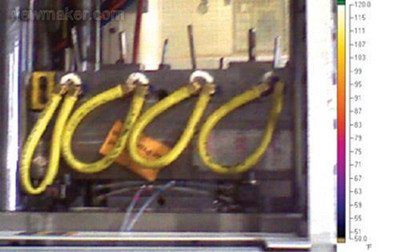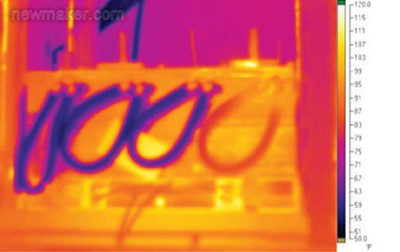Digital Thermal Imaging Technology in Die Manufacturing
If your company has never used digital thermal imaging technology, or if you have never been involved in this technology and are not satisfied with the results you have obtained, or have really not really kept pace with the development of this technology, then now It is time to look at this technology with a new eye. When you come in contact with a new tool and run it, or when you are in trouble shooting practice, the best thing to do is to take quick action. Digital thermal imaging is one of the best tools to quickly find the root cause of molding problems. If you have a problem with the tool you are using or the project you are responsible for, you can also use an infrared camera ("IR") to capture it as an image. In hundreds of different situations, using thermal imaging technology can quickly generate useful data, saving you and your customers time and money. In the plastics processing business, there are both technical and business drivers that are accelerating the use of thermal imaging technology. Therefore, these issues are worth discussing. Technology and Business From a technical point of view, the latest developments in infrared cameras allow it to shoot from one image to several tens of images per second. This shooting capability can explain in detail exactly what happens to the mold and its parts during heating and cooling. All issues. Infrared cameras are also increasingly compact and compact, and in theory, some cameras are small enough to fit into their pockets. Current infrared cameras are reasonably priced (approximately $3,000 to $12,000) and can be purchased from many suppliers. The cost of equipment is no longer a real problem. From a commercial point of view, one of the basic functions of the thermal imaging technology is to effectively help improve production efficiency in troubleshooting operations, and eliminate or reduce as much as possible the expensive cost of mold removal. For example, if a molder has a 30-point manifold system, which usually requires a 12-hour split time, and thermal imaging technology helps to quickly find the root cause, we can guarantee that in 2~3h, we need to determine which places need to be fixed. Amend this to help save money. The funds saved due to the increase in productivity are considerable, enough to have a different impact on the bottom line of the molders. As a moldmaker or a supplier of manifolds, when you can increase productivity for your customers, no matter what the problem or whoever is wrong, you can quickly find the cause. Market power You can use an infrared camera to record the thermal imaging profile after the power is turned on for the mold and its parts. Ideally, you can use mold flow data to compare with infrared images. However, in many cases, this method is not very practical and has become a growing problem. In North America, there are so many molds that can be traded. Whether it is a domestic or international transaction, most of the historical data and data of these molds may have been lost or even permanently lost. When molders and mold makers inherit these molds, the problem is how to make them work as quickly and economically as possible, and let them produce qualified parts. When you try to get these molds to work and run, as a thermoforming reviewer, as one of the full set of mold reviewers, it is decisive. Thermal imaging technology is a great tool that can provide useful information, including not only technical/intelligent processing-type information, but also significant financial implications for those molds and their potential impact on their companies and their operations. Decision-making individuals provide information. The second market driver for digital thermal imaging technology is when time becomes money. For example, digital imaging technology will become a very useful tool when problems occur in daily mold-forming operations. Our goal is to shorten the time it takes for technicians to diagnose and identify problems. Whenever there is a problem with the mold forming operation, mold makers and manifold suppliers are often required to solve the problem, whether it is a temporary emergency or not. The two most common problems are: (1) the surface quality of the nozzle and mold is poor; (2) the manifold system is not assembled correctly. Poorly installed manifolds may sometimes come from suppliers, but often begin to have internal problems when the economic situation is not good. When the cost is tight, mold makers often make manifold housings or assemble their own manifold systems. However, when such systems have problems, the most frequent problem is that the circuit layout is not reasonable. Other common problems include improper water connection and poor quality. Some of the molds or inserts do not cool properly, negatively affecting the cooling time. In many cases, you can use a video camera to take a picture of the press, observe the water circulation loop on its side, and determine if they are properly connected (Figure 1, 2). The molder may say that leaks have occurred in these lines, the depth of the connection pipe is not enough, or the circuit is not good. Since the maintenance funds for the molds are not taken into account in the budget, they can only accept the loss of high scrap rates and time. Figure 1 Water line layout of the mold Figure 2 water infra-red image of the mold In a complex valve mold with multiple points, there is a cylinder directly mounted on the manifold system. When a thermal imaging camera is used as a rapid identification method, it can be determined whether the water line leading to the cylinder is broken. Because it can cause a seal failure in the cylinder. Thermal imaging is one of the quickest and easiest ways to identify such problems, so many times you can save hours of troubleshooting and identify problems so that you can quickly correct them. Provide solutions for your customers So let's take a look at the market environment we operate in. For everyone, the profit margins are tight, and the demand for knowledge, speed, and productivity has never been so great, especially when something goes wrong. If you can't provide a solution, maybe your competitors will provide it. Digital thermal imaging is one of the best tools for providing solutions for your customers. If you have a video camera, it is best to use it at any time. If you haven't already, then now is the best time to invest in cameras.
Aiming to reduce the time to load a roll to the minimum point, this Double Head Decoiler type drives one of the rolls, as the other one waits as a backup.
When the driven roll is over, the backup roll will be ready to be connected to the driver within a very short period of time. When you connect the new roll to the driver, you will have a long time to load another spare roll. Double head Decoiler is an ideal solution for production plants where production speed and continuity are crucial in serial manufacturing. So usually configured with the S loop straightener, high speed gear machine and H Frame High Speed Press Machine, it`s usually suitable for motor rotor and stator lamination stamping.
Double Head Decoiler Double Head Decoiler,Double Head Mini Decoiler,Steel Strip Double Head Decoiler,Hydraulic Double Head Decoiler,Automatic Sheet Decoiler Machine,Dual Decoiler Mayflay Machinery(huizhou) Co.,LTD , https://www.pressfeeders.com
